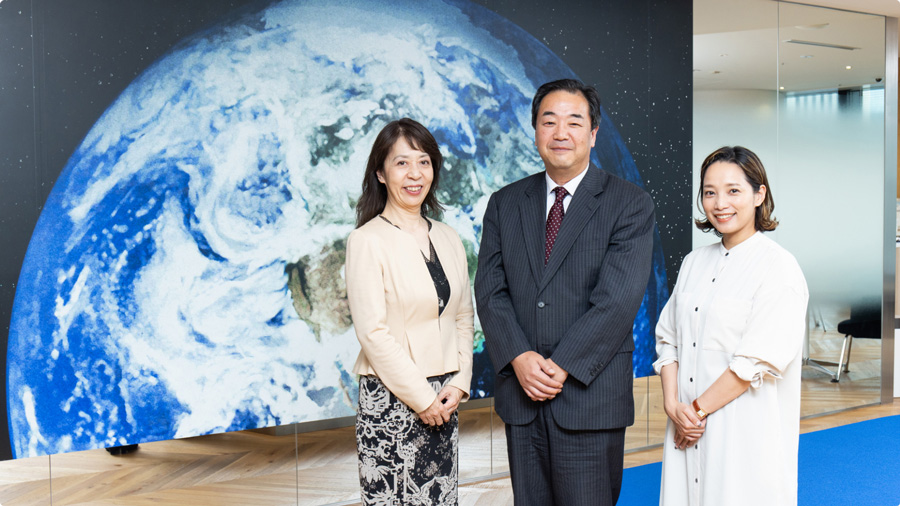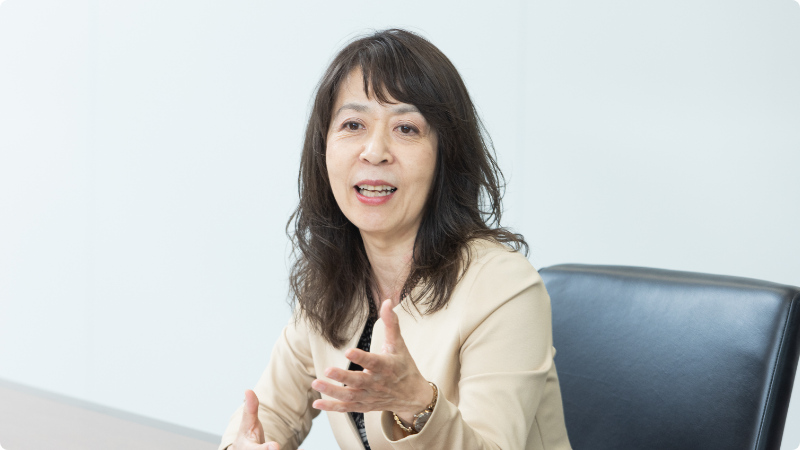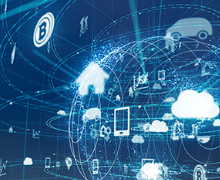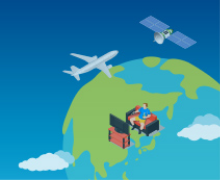- Sustainability
- Materiality
- Dialogue with Expert
FY2023: Dialogue with Expert (Environment)
Importance of management’s storytelling on response to risks and opportunities of environmental issues
May 31, 2023
Introduction of Participants
![]()
Ms. Mari Yoshitaka
Fellow (Sustainability), Mitsubishi UFJ Research and Consulting Co., Ltd. Adjunct Lecturer, Graduate School of Arts and Sciences, The University of Tokyo
See bottom of page for detailed profile.
![]()
Koichi Matsutani
Sustainability Committee Chair
Director
![]()
Nao Shigenari
General Manager of Planning & Administration
Division,
Space Business Unit, SKY Perfect JSAT Corporation
※Positions are as of May 2023
Reviewing materialities based on consistency with business vision and strategy
The SKY Perfect JSAT Group launched the Sustainability Committee in September 2020, and established the Sustainability Department in 2022. I feel that the organization is moving very quickly towards sustainability.
Thank you for saying so. The SKY Perfect JSAT Group has set “Contributing to the environment to make a decarbonized society and circular economy a reality” as a materiality theme, and aims to achieve a 100% usage rate of renewable energy by 2030. In fiscal 2022, we switched to renewable energy at the SKY PerfecTV! Tokyo Media Center, which consumes a large amount of electricity. This increased the usage rate of substantial renewable energy for the entire Group to 93%. We have also set new targets to achieve Scope 1 and Scope 2 carbon neutrality by 2030, and Scope 3 carbon neutrality, which includes the entire supply chain, by 2050.
What is the source of your rapid progress in environmental response?
The young generation, including young employees at the SKY Perfect JSAT Group, has a high level of awareness of SDGs and ESG. Young employees create opportunities by spreading these concepts. In response, management has absorbed this awareness and accelerated initiatives as an organization in response to the demands of society.
Many companies often take a top-down approach to ESG from their management
meetings. In most cases, management fails to take action based on proposals
from employees. Having been involved in the financing of climate change
countermeasures for nearly 20 years, I feel that sustainability initiatives
take time. However, your company is very unique in how young employees are
working with a high level of ESG awareness.
From our last meeting, I
also remember how your company has thorough procedures to identify
materialities. It seems that you have revised some materialities. What
process did you take in the revision?
We reviewed themes keeping in mind consistency with our business vision and business strategy which we formulated after identification, as well as external requests. We newly added “Development and promotion of our NTN (non-terrestrial network) business” and “respect for human rights” to our materialities, which means that we have identified a total of 23 issues. Although 23 is a large number of issues, I am looking to the future and what we can actually accomplish.
The number of materialities varies depending on the type of business and
industry. For example, when it comes to decarbonization, a temporary
materiality is not enough. Even if a materiality is determined once, it must
be reviewed as necessary according to the situation. Therefore, there is no
need to think of 23 issues as a large number.
Given the current
situation where unexpected events happen, it is appropriate to review
materialities every year. The role of management is to tell a story on
important issues for the company as it promotes its business activities, and
on how to bridge the gap between the future vision and the management
strategy that is being built on a daily basis. It is important to carefully
explain the background and process behind reviewing materialities.
In
addition to materialities, it is important to be able to explain your
company’s initiatives to your stakeholders, including investors, local
governments, and employees. This also helps maintain good relationships with
partner companies.

Solar-powered satellite communications are a green service,
and the rate of
renewable energy at ground bases has risen to 93%
Speaking of satellite communications, in addition to the fact that satellites use solar power for operation, our ground-based stations are also powered by substantial renewable energy. In this way, satellite communications can be described as a service that uses green energy. We believe that these characteristics will be viewed as particularly valuable to industries such as the aviation industry, which is paying a lot of attention to the environment, and the shipping industry, which is working on ammonia fuel.
Keeping in mind ESG investors who invest from a long-term perspective, it would be prudent to include more information like this in integrated reports. It is also noteworthy that the renewable energy rate rose to 93% from 30% in the previous year.
We actually reduced Scope 2 by purchasing non-fossil certificates. Broadcasting satellites and communication satellites in space are basically powered by solar power. The rate of renewable energy can be significantly increased by using substantial renewable energy for the ground-based stations that control the satellites. The only thing left to do is decide on the cost of switching.
Deciding on the type of investment and cost for reducing CO2 emissions is a
business decision. One of the reasons why the Task Force on Climate-related
Financial Disclosures (TCFD) requires the disclosure of information is to
determine the financial impact on companies. The GX League, led by the
Ministry of Economy, Trade and Industry, is discussing a carbon tax to
reduce CO2 emissions and improve industrial competitiveness. I recommend
that your company perform financial simulations which consider factors such
as the use of non-fossil certificates, while also comparing the impact of
future carbon taxes.
On the other hand, it is also important to view
climate change countermeasures as a business opportunity. What are your
thoughts on measures to adapt to climate change?
In relation to the materiality of “Promoting innovation which contributes to the environment and society,” we are advancing the LIANA project that utilizes remote sensing. In addition to using satellites to monitor changes in slopes and infrastructure, we are using satellite data to analyze environmental information, including vegetation changes and the impact of invasive species, in rivers throughout Japan and national parks specified by the Ministry of the Environment. I believe that we can communicate information on these efforts.
These are also initiatives related to the Taskforce on Nature-related Financial Disclosures (TNFD). The issues of climate change and biodiversity are two sides of the same coin. It’s important to enable management to tell its story while balancing opportunities and risks.

Profile

Ms. Mari Yoshitaka
After graduating from the School of Law, Meiji University, worked at IT companies and American investment banks. MSc from the School for Environment and Sustainability (SEAS) (current name), University of Michigan. PhD from the Graduate School of Media and Governance, Keio University. Has been engaged in environmental finance consulting work both in Japan and overseas for many years. Currently provides advice on sustainable management and finance to a variety of sectors. Holds concurrent positions at MUFG Bank and Mitsubishi UFJ Morgan Stanley Securities. Members of various organizations such as the Ministry of the Environment’s Global Environment Committee of Central Environment Council, Financial Services Agency’s Expert Panel on Sustainable Finance, and the Ministry of Agriculture, Forestry and Fisheries’ Council of Food, Agriculture and Rural Area Policies.
Other expert third-party opinions and dialogues
FY2023
FY2020
- Expert’s opinion on identification of materiality themes (from the perspective of ESG investment)
- Expert’s opinion on identification of materiality themes (from the perspective of disclosing sustainability information)
- Expert’s opinion on identification of materiality themes (from the perspective of CSV based on the SDGs)




